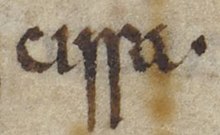Cissa dari Sussex
| Cissa | |
|---|---|
| Raja Sussex | |
 Penyebutan tentang Cissa, putra Ælle, dalam Kronik Anglo-Saxon | |
| Berkuasa | 514–567? |
| Pendahulu | Ælle |
| Penerus | Æthelwealh dari Sussex |
| Anak | tidak diketahui |
Cissa merupakan seorang raja Saxon legendaris dari Sussex, ia adalah putra dan penerus Ælle yang bertakhta pada sekitar tahun 514 atau 515. Ia meninggal tanpa keturunan. Setelah kematiannya, raja Wessex Ceawlin merebut Sussex, yang dilanjutkan oleh penerusnya Ceolric dan Ceolwulf. Pada tahun 648, Æthelwealh dimakzulkan sebagai raja Sussex oleh Saxon Barat.
Ia akan memberikan namanya ke kota Chichester.
Catatan[sunting | sunting sumber]
Referensi[sunting | sunting sumber]
- Asser (2004). Keynes, S., ed. Alfred the Great. Penguin Classics. Diterjemahkan oleh Lapidge, M. Penguin Books. ISBN 978-0-14-044409-4.
- Bede (1991). D.H. Farmer, ed. Ecclesiastical History of the English People. Diterjemahkan oleh Leo Sherley-Price. Revised by R.E. Latham. London: Penguin. ISBN 0-14-044565-X.
- Bedwin, Owen, ed. (1980). "Sussex Archaeological Collections Vol. 118". Lewes, Sussex: Sussex Archaeological Society.
- Bell, Martin (1978). Drewett, P. L., ed. "Saxon Sussex; Archaeology in Sussex to AD 1500: essays for Eric Holden".
- Brandon, Peter (1978). The South Saxons. Chichester: Phillimore. ISBN 0-85033-240-0.
- Camden, William (1610). Britannia Vol 1 (edisi ke-English). London: Philemon Holland.
- Dodgson, J. McNeil (1978) "Place-names in Sussex", in: Brandon, Peter, ed. The South Saxons. Chichester: Phillimore ISBN 0-85033-240-0
- Down, Alec (1978) "Roman Sussex: Chichester and the Chilgrove Valley", in: Drewett, Peter, ed. Archaeology in Sussex to A.D. 1500 (Research Reports; Council for British Archaeology; no. 29) London: Council for British Archaeology ISBN 0-900312-67-X
- "Key to English Placenames". EPNS. Diakses tanggal 29 December 2009.
- Fouracre, Paul, ed. (2006). The New Cambridge Medieval History, Vol. 1: c. 500 – c. 700. Cambridge University Press. ISBN 0-521-36291-1.
- Dumville, David; Keynes, Simon (1986). Bately, J.M, ed. The Anglo-Saxon Chronicle. 3 MS A. Cambridge: D.S. Brewer. ISBN 978-0-85991-103-0.
- Freke, D. J. (1980). "Excavations in the Parish Church of St Thomas the Martyr, Pagham". Sussex Archaeological Collections (118).
- Gransden, Antonia (1974). Historical Writing in England c.550-c1307. London: Routledge and Kegan Paull. ISBN 0-7100-7476-X.
- Gelling, Margaret (2000). The Landscape of Place-Names. Stamford: Tyas. ISBN 1-900289-26-1.
- Hudson, T. P. (1982). "The place-name 'Cissbury'". Sussex Archaeological Collections (120).
- Henry of Huntingdon (1996). Greenway, Diana E., ed. Historia Anglorum: the history of the English. Oxford: OUP. ISBN 0-19-822224-6.
- Jones, Michael E. (1988). The End of Roman Britain. Ithaca, New York: Cornell University Press. ISBN 0-8014-8530-4.
- Kelly, Susan E., ed. (1998). Charters of Selsey. Anglo-Saxon Charters VI. OUP for the British Academy. ISBN 0-19-726175-2.
- Kipfer, Barbara Ann, ed. (2000). Encyclopedic Dictionary of Archaeology. New York: Kluwer Academic/ Plenum Publishers. ISBN 0-3064-6158-7.
- Kirby, D. P.; Williams, J. E. C. (1976). "Review of The Age of Arthur, a History of the British Isles from 350 to 650 by John Morris". Studica Celtica (10–11).
- Morris, John (1973). The Age of Arthur. London: Phoenix. ISBN 1-84212-477-3.
- Morris, John (1965). Jarrett; Dobson, ed. Britain and Rome : Dark Age Dates: essays presented to Eric Birley on his 60th birthday.
- Roger of Wendover (1849). Roger of Wendover's Flowers of History VI. Diterjemahkan oleh Giles, J. A. London: Henry G. Bohn.
- Slaughter, David (2009). Rulers of the South Saxons before 825. Published by Author.
- Swanton, Michael (1996). The Anglo-Saxon Chronicle. New York: Routledge. ISBN 0-415-92129-5.
Pranala luar[sunting | sunting sumber]
- St Thomas a Becket - Parish Church at the East end of Pagham Harbour Various AS artefacts found in the area including a cremation urn restored and dated by British museum.
